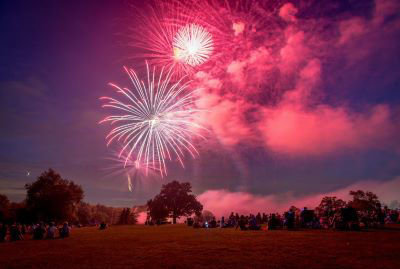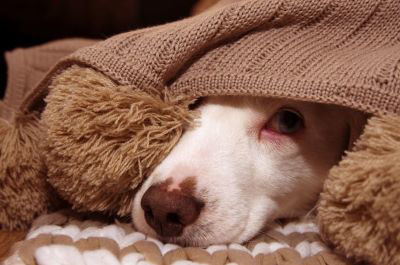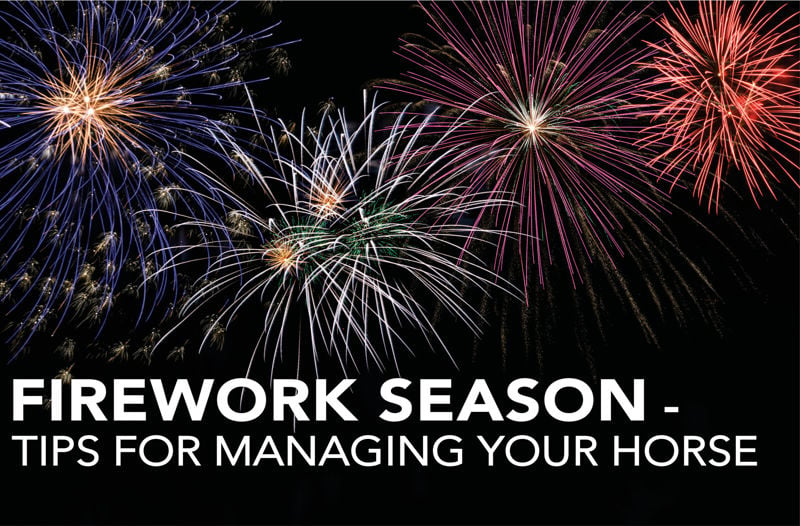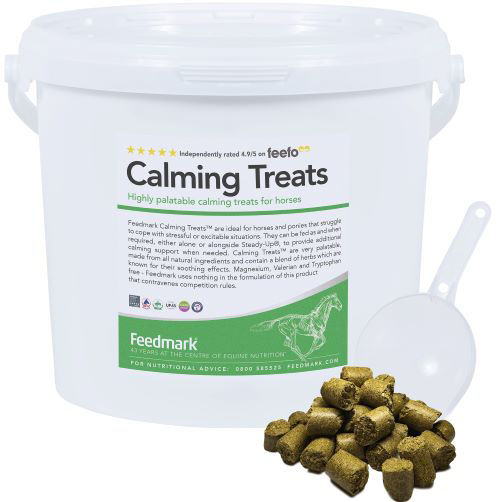Autumn is known for fireworks due to Halloween and Guy Fawkes celebrations taking place. Such celebrations often negatively impact animals and cause stress for owners. Fireworks are generally associated with loud bangs, sudden beams of light and burning smells, all of which can cause fear, distress and trigger the flight-or-fight responses in horses, dogs and many other animal species.
Horses are flight animals that have acute hearing and are highly reactive to loud noises and flashing lights. When faced with such situations many horse´s main instinct is to run away with the hope of escaping the unpleasant experience. Dogs, on the other hand, being smaller than horses, will tend to run and hide in an area they consider safe, away from danger.
A distressed animal can be dangerous towards itself, other animals and people around them, therefore, it is our responsibility as owners to keep our animals as calm as possible during these rare but frightening celebrations. As fireworks are now often used as part of Halloween celebrations, not just for Guy Fawkes, it is important to plan how you are going to manage your horses or dogs over a number of weeks, and to make adjustments to their management in the weeks leading up to this challenging period. We can´t take the fireworks out of the celebrations, but we can do our best to keep our animals calm and safe!

Figure 1: Many people enjoy fireworks however, the bright lights, loud bangs and smoke can frighten animals.
HORSES
BEFORE FIREWORK NIGHT:
- Ask neighbours, family and friends about any upcoming events or events planned themselves, as well as monitor local newspapers and social media pages for information.
- If you are participating in fireworks displays, consider the use of silent or low noise fireworks as they still produce the cascading colours but without the startling loud explosions, reducing the anxiety many horses feel.
- Provide a safe environment to prevent injury: check stables for loose nails and sharp edges, and fields for secure fencing and foreign objects.
- Make sure you have up to date third party liability insurance in case there was to be an accident.
- Get horses used to radio noise on the yard, this will help distract horses from firework bangs during events.
- In terms of their feeding schedule bear in mind the possible times firework displays are to take place and plan an appropriate time to feed as this will act as a distraction for them.
- Make sure you and your team members have an emergency fire plan in place to ensure horses can be brought to safety in case of an emergency.
- If your horse will stay stabled during firework events and this is not their normal routine, gradually change their management a few weeks prior to firework night so the change in environment does not add to their distress and confusion.
- If your horse is particularly nervous it may be worth feeding a calmer such as Steady-Up® for a couple of weeks before the events and throughout the celebrations to help them settle. This supplement contains Brewer´s Yeast, supplying naturally occurring B vitamins that support normal neurological functions (Calderón-Ospina et al., 2020) as well as providing amino acids, including Tryptophan. Tryptophan is a precursor for creating serotonin acting as a chemical messenger inhibiting stress and fear in various animal species (Davis et al., 2017). In addition to this, Steady-Up® contains Lemon balm, a herb which acts to reduce anxious behaviour (Taiwo et al., 2012), and Chamomile which also has a calming and soothing effect (Avallone et al., 1996). Combined these ingredients help to keep your horses steady during this stressful period.
Steady-Up® - Ideal supplement for horses of a nervous or excitable nature.
If you are looking to offer extra support have a look at Feedmark Calming Treats. These are ideal for horses and ponies that struggle to cope with stressful or excitable situations such as fireworks. They can be fed as and when required, either alone or alongside Steady-Up®, to provide additional calming support when needed. Calming Treats are very palatable, made from all natural ingredients and contain a blend of herbs which are known for their soothing effects.
ON THE DAY:
- Maintain their normal routine as this will keep them settled and reassured.
- Provide ad-lib hay or haylage to keep them entertained. Be cautious when hanging distractions such as licks or swedes as although they are inviting, they introduce a new hazard if the horse were to panic.
- Turn on the radio and lights to drown out the noise and disguise the sudden flashing from the fireworks.
- If rugged, it is advised to put them in a fleece as it will wick away any sweat caused by distress. If turned out, consider putting a rug underneath their turnout rug to wick off sweat.
- Check on horses regularly as the night goes on and after the firework display.
- Ensure personal safety equipment, such as helmets, boots and gloves, are available for everyone in the yard in case they need to handle excited or stressed horses.
- Consider removing water buckets from the stables during the firework display to reduce the likelihood of them being knocked over. If the buckets were knocked over and the stable flooded it could cause more distress.
- For maximum security, shut any exterior gates in case a horse manages to get escape from its stable or field.
AFTER FIREWORK NIGHT:
- Check over horses in daylight for any injuries or scratches.
- Thoroughly check the fields and the yard for any debris caused by the fireworks.
DOGS
BEFORE FIRE WORKS NIGHT:
- Ask neighbours, family and friends about any upcoming events or events planned themselves, as well as monitor local newspapers and social media.
- Make sure your house is secure and escape-proof: close windows and curtains if inside, and secure fencing if outside.
- If you have your dog indoors during firework events and they are not used to it, change their routine a few weeks prior to the event to give them a chance to settle. Vice versa if they are routinely kept indoors and you would prefer them to be outdoors.
- Create a safe place for them. This could be a little area where they are comfortable with their favourite bed and toy.
- During firework season, walk your dogs during daylight as this will help relax them before it becomes too noisy at night.
- To help disguise the loud banging noise, switch on a TV or radio. Allow them to adapt to this new noise a few weeks prior to firework displays.
- Make sure your dog´s microchip and insurance are up to date in case there were to be any accidents.
- If their safe place is a kennel, partially cover them with a blanket to make them sound-proof.
- Consider introducing a calmer in their feed such as Calm-a-pet a few weeks prior to the celebrations and throughout the events to help them feel relaxed and reduce anxiety. This supplement contains herbs such as passionflower, proven as a successful treatment for anxiety symptoms (Dhawan et al., 2003) and Chamomile which exerts a settling and tranquilizing effect (Avallone et al., 1996). Hops are also included as they aid nocturnal sleep (Hejazian et al., 2014). This combination of ingredients will help to keep your dog as relaxed as possible during these occasions.

Figure 3: Dogs will usually find a safe, quite place to hide during fireworks.
ON THE DAY:
- Follow their normal routine as much as possible, feed and exercise them as normal.
- If possible, do not leave them alone during the event, having people around will make them feel secure and reassured.
- Provide entertainment, play games and keep the TV or radio on to drown out noise.
AFTER FIREWORK NIGHT:
- Check for any debris in the garden before letting your dog out as this may harm them
REFERENCES
Avallone, R., Zanoli, P., Corsi, L., Cannazza, G., & Baraldi, M. (1996). Benzodiazepine-like compounds and GABA in flower heads of Matricaria chamomilla. Phytotherapy Research, 10: 177 – 179. Italy: John Wiley & Sons Ltd.
Calderón-Ospina, C. A., & Nava-Mesa, M. O. (2020). B Vitamins in the nervous system: Current knowledge of the biochemical modes of action and synergies of thiamine, pyridoxine, and cobalamin. CNS neuroscience & therapeutics, 26(1): 5–13. doi.org/10.1111/cns.13207
Davis, B., Engle, T., Ransom, J., & Grandin, T. (2017). Preliminary evaluation on the effectiveness of varying doses of supplemental tryptophan as a calmative in horses. Applied Animal Behaviour Science, 188: 34-41.
Hejazian, S. H., Bagheri, S. M., & Dashti-R, M. H. (2014). Relaxant effect of Humulus lupulus extracts on isotonic rat's ileum contractions. Avicenna journal of phytomedicine, 4(1): 53–58.
Dhawan, K., Kumar, S., & Sharma, A. (2003). Evaluation of Central Nervous System Effects of Passiflora incarnata in Experimental Animals, Pharmaceutical Biology, 41(2): 87-91. doi:10.1076/phbi.41.2.87.14241
Taiwo, A. E., Leite, F. B., Lucena, G. M., Barros, M., Silveira, D., Silva, M. V., & Ferreira, V. M. (2012). Anxiolytic and antidepressant-like effects of Melissa officinalis (lemon balm) extract in rats: Influence of administration and gender. Indian journal of pharmacology, 44(2): 189–192. https://doi.org/10.4103/0253-7613.93846




